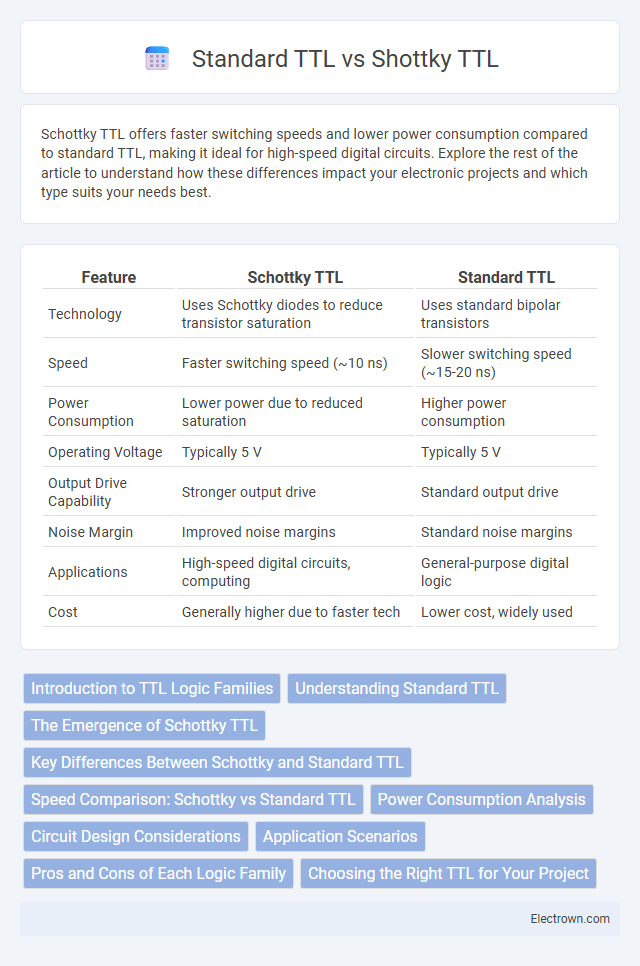Schottky TTL offers faster switching speeds and lower power consumption compared to standard TTL, making it ideal for high-speed digital circuits. Explore the rest of the article to understand how these differences impact your electronic projects and which type suits your needs best.
Table of Comparison
| Feature | Schottky TTL | Standard TTL |
|---|---|---|
| Technology | Uses Schottky diodes to reduce transistor saturation | Uses standard bipolar transistors |
| Speed | Faster switching speed (~10 ns) | Slower switching speed (~15-20 ns) |
| Power Consumption | Lower power due to reduced saturation | Higher power consumption |
| Operating Voltage | Typically 5 V | Typically 5 V |
| Output Drive Capability | Stronger output drive | Standard output drive |
| Noise Margin | Improved noise margins | Standard noise margins |
| Applications | High-speed digital circuits, computing | General-purpose digital logic |
| Cost | Generally higher due to faster tech | Lower cost, widely used |
Introduction to TTL Logic Families
TTL (Transistor-Transistor Logic) logic families include Standard TTL and Schottky TTL, both used in digital circuits for switching and signal processing. Schottky TTL integrates Schottky diodes to reduce switching times and power consumption, offering faster operation compared to Standard TTL, which relies on slower transistor switching. Understanding the benefits of Schottky TTL can enhance Your circuit design by improving speed and efficiency in high-frequency applications.
Understanding Standard TTL
Standard TTL (Transistor-Transistor Logic) uses bipolar junction transistors to perform digital logic operations, offering moderate switching speeds and power consumption suitable for many basic applications. It typically operates at 5V with input thresholds around 0.8V for logic low and 2.0V for logic high, featuring propagation delays around 10 ns. Standard TTL's robust noise immunity and straightforward design make it a foundational technology, though it may consume more power and switch slower compared to Schottky TTL variants.
The Emergence of Schottky TTL
The emergence of Schottky TTL marked a significant advancement in transistor-transistor logic by incorporating Schottky diodes to reduce transistor saturation and improve switching speed. Schottky TTL circuits exhibit faster response times and lower power consumption compared to standard TTL, making them ideal for high-speed digital applications. This innovation addressed the limitations of standard TTL by minimizing storage delay and enhancing overall performance in integrated circuits.
Key Differences Between Schottky and Standard TTL
Schottky TTL transistors incorporate Schottky diodes, significantly reducing switching times and power dissipation compared to standard TTL, which relies on bipolar junction transistors without these diodes. Your circuits will benefit from faster switching speeds, typically in the nanosecond range, and lower power consumption when using Schottky TTL, making it ideal for high-speed digital applications. Standard TTL offers simpler design and lower cost but sacrifices speed and efficiency, which can lead to higher power use and slower performance in demanding environments.
Speed Comparison: Schottky vs Standard TTL
Schottky TTL offers significantly faster switching speeds compared to Standard TTL due to the incorporation of Schottky diodes, which reduce transistor saturation and increase switching efficiency. Typical propagation delays for Schottky TTL gates range from 3 to 5 nanoseconds, while Standard TTL generally operates around 10 nanoseconds or more, making Schottky TTL ideal for high-speed digital circuits. Choosing Schottky TTL can enhance your circuit's overall performance by minimizing delay and improving response time in timing-critical applications.
Power Consumption Analysis
Shottky TTL circuits offer significantly lower power consumption compared to Standard TTL due to their faster transistor switching speeds and reduced saturation voltage, which decreases wasted energy during transitions. This efficiency makes Shottky TTL ideal for battery-powered or energy-sensitive applications where Your device requires optimal power management. The improved speed-to-power ratio also reduces heat generation, enhancing overall system reliability and performance.
Circuit Design Considerations
Shottky TTL circuits incorporate Schottky diodes to reduce transistor saturation, improving switching speed and minimizing power dissipation compared to Standard TTL. The circuit design requires careful diode integration to prevent latch-up and maintain voltage levels within specified TTL logic thresholds. Designers often balance these factors to optimize performance in high-speed digital applications while ensuring signal integrity and noise immunity.
Application Scenarios
Shottky TTL is ideal for high-speed digital circuits, such as computer processors and communication devices, where fast switching times and reduced power consumption are critical. Standard TTL suits less speed-sensitive applications like simple logic circuits, indicator controls, and basic timing devices where cost-efficiency outweighs ultra-fast response. Your choice depends on the performance requirements and power constraints of the specific application environment.
Pros and Cons of Each Logic Family
Schottky TTL offers faster switching speeds and lower propagation delay compared to Standard TTL, making it ideal for high-speed applications, though it consumes more power. Standard TTL benefits from lower power consumption and better noise immunity, but its slower switching speed limits its performance in high-frequency circuits. Selecting between the two depends on the trade-off between speed requirements and power efficiency in digital circuit design.
Choosing the Right TTL for Your Project
Shottky TTL offers faster switching speeds and lower power consumption compared to Standard TTL, making it ideal for high-frequency or power-sensitive applications. Standard TTL, while slower, provides compatibility with a broader range of older digital circuits and is often sufficient for general-purpose use. Selecting the right TTL depends on project requirements such as speed, power efficiency, and circuit compatibility, ensuring optimal performance and reliability.
Shottky TTL vs Standard TTL Infographic

 electrown.com
electrown.com